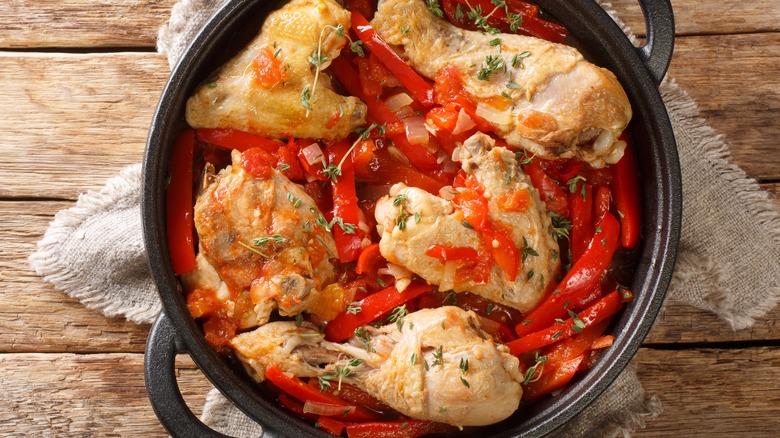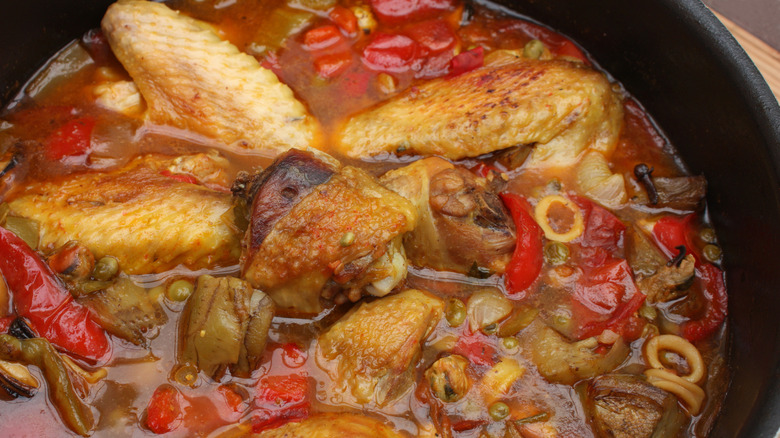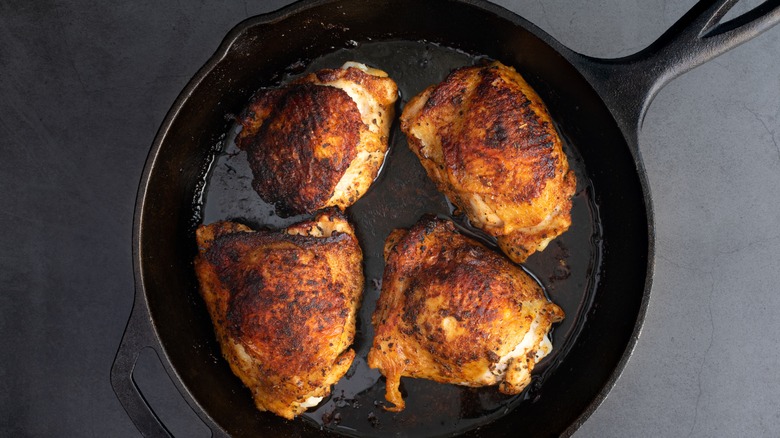Basque Chicken Is A Comforting Stew With French And Spanish Influences
Chicken and dried peppers are a delicious combo — take Hungarian chicken paprikash, for example. Especially when slow-cooked, the white meat perfectly melds with the savory nature of the spice, often accompanied by a tomato tang.
In the border region between France and Spain, an aromatic spin on the poultry and pepper combo is called Basque chicken. Hailing from the Basque culinary hotspot area on the Atlantic, it's no surprise the food is bursting with flavor. Crafted with chicken, bell peppers, herbs, wine, cured pork, and espelette — a particularly aromatic dried pepper spice — the stew is equal parts comforting and wondrous. Plus, it showcases Basque pride, with the multi-colored bell peppers said to resemble the region's flag.
Best of all, the dish is easy to make in a home kitchen, too. If the Basque espelette is hard to track down, it can be substituted with paprika, and the rest comes together in a fragrant, simmering swoop. Let's see how this delectable dish came about.
Background of Basque chicken
The vibrant dish — known as poulet Basquaise in French — hails from the Basque Country, a region noted in its name. This autonomous area sits in what is called the Pyrénées-Atlantiques département, and is culturally distinct from the surrounding regions. It is especially renowned for its gastronomy. The cuisine relies on the use of fresh, local produce, which is found in varied forms, including pork, seafood, poultry, and an extensive range of vegetables. Stews are especially popular, and the most prominent spice is espelette — a local pepper. Nowadays, Basque chicken has deviated and become popular in the Basque Country, Spain, and France, with regional variations. In Spain, it employs smoked pimentón and serrano ham in a spin-off version known as pollo al chilindrón. Meanwhile, in France, it comes with domestically popular Bayonne ham. Regardless of the exact interpretation, Basque chicken is a delicious stew bursting with flavor.
How Basque chicken is prepared
The dish's preparation kicks off with the browning of ingredients. First, the ham or chorizo sausage hits the hot oil, and is then set aside. It's then followed by the salt-seasoned chicken, which can encompass a range of cuts from thighs, to drumsticks, and breasts, typically with the skin on. Once browned, the chicken is removed.
Next come the vegetables — an optional mix of onions, shallot, garlic, piquillos, or bell peppers — which are softened and mixed in with tomatoes. The key here is mixing the aromatics with the leftover browned bits, constructing an aromatic sauce. A white wine deglaze follows, cleansing the pan for initiation of stewing. Chicken stock is poured in alongside the ham and chicken, whose skin is left to submerge into the liquid. During this process, a bouquet garni is added for flavor, comprised of thyme and parsley. The mixture may be cooked down with paprika but not with espelette, which is a finishing spice.
Basque chicken is enjoyed alongside rice and potatoes. A spoonful of chopped parsley usually lends the dish a splash of green, while some also add apples for a brighter tang. And as per most southern European foods, a glass of red wine is a perfect complement.


